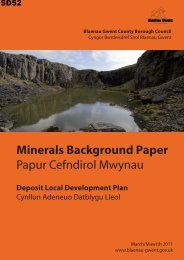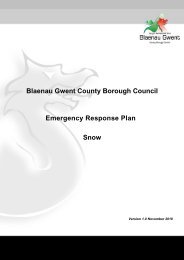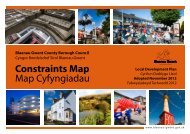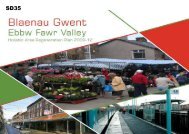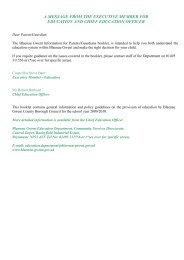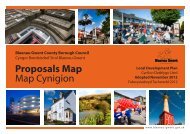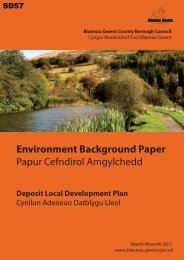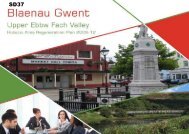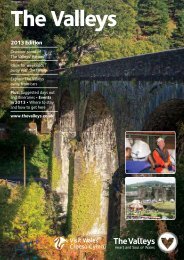Access Car Parking & Design - Blaenau Gwent County Borough ...
Access Car Parking & Design - Blaenau Gwent County Borough ...
Access Car Parking & Design - Blaenau Gwent County Borough ...
You also want an ePaper? Increase the reach of your titles
YUMPU automatically turns print PDFs into web optimized ePapers that Google loves.
<strong>Blaenau</strong> <strong>Gwent</strong> <strong>County</strong> <strong>Borough</strong> Council<br />
Cyngor Bwrdeisdref Sirol <strong>Blaenau</strong> <strong>Gwent</strong><br />
Draft Supplementary Planning Guidance<br />
<strong>Access</strong><br />
<strong>Car</strong> <strong>Parking</strong> &<br />
<strong>Design</strong><br />
April 2012<br />
www.blaenau-gwent.gov.uk
<strong>Access</strong>, <strong>Car</strong> <strong>Parking</strong> and <strong>Design</strong><br />
Contents<br />
Page<br />
1.0 Introduction 1<br />
2.0 The Policy Context 1<br />
3.0 Issues 2<br />
4.0 Planning Considerations and Requirements 8<br />
Tables<br />
Table 1: Thresholds above which a TA will be required 5<br />
Appendices<br />
Appendix 1: <strong>Parking</strong> Guideline Notes and Guideline Tables<br />
Appendix 2: <strong>Car</strong> <strong>Parking</strong> Zones<br />
Supplementary Planning Guidance April 2012
<strong>Access</strong>, <strong>Car</strong> <strong>Parking</strong> and <strong>Design</strong><br />
<strong>Blaenau</strong> <strong>Gwent</strong> <strong>County</strong> <strong>Borough</strong> Council<br />
Draft Supplementary Planning Guidance<br />
<strong>Access</strong>, <strong>Car</strong> <strong>Parking</strong> and <strong>Design</strong><br />
1.0 INTRODUCTION<br />
1.1 This Draft Supplementary Planning Guidance (SPG) has been produced to<br />
provide guidance on access, circulation and parking in the planning process.<br />
1.2 Following adoption by the Council, this SPG will be a material consideration in<br />
the determination of all categories of development for which permission is<br />
required, including new developments, extensions, redevelopments,<br />
conversions and material changes of use. The guidance contained in this<br />
document will help ensure a transparent approach to the provision of parking,<br />
travel plans and transport assessment and, crucially, will inform applicants of<br />
the Council’s expectations at an early stage of the development process.<br />
2.0 POLICY CONTEXT<br />
2.1 The <strong>Blaenau</strong> <strong>Gwent</strong> Local Development Plan (LDP) sets out planning policies<br />
that will be applied in the <strong>County</strong> <strong>Borough</strong> apart from the Brecon Beacons<br />
National Park. This SPG provides supporting information with regard to the<br />
transport policies included in the LDP. It provides details that would not be<br />
appropriate in the more strategic LDP.<br />
2.2 The SPG principally supports the following LDP Policies, although other<br />
policies in the LDP also require consideration of transportation implications:<br />
SP6 Ensuring <strong>Access</strong>ibility<br />
The Council will work with partner organisations, including the Welsh<br />
Assembly Government, South East Wales Transport Alliance, public<br />
transport operators, community transport providers, Network Rail<br />
and neighbouring Authorities to deliver a sustainable transport<br />
network which:<br />
1. Increases connectivity through improving rail, bus and road links:<br />
a. With other key settlements in the South East Wales Region,<br />
Wales, the UK and Europe;<br />
b. Between the principal hub of Ebbw Vale and other identified<br />
district hubs (Tredegar, Brynmawr and Abertillery);<br />
2. Facilitates and supports economic growth, regeneration and<br />
development priorities; whilst minimising harm to the built and<br />
natural environment and local communities;<br />
Supplementary Planning Guidance 1<br />
April 2012
<strong>Access</strong>, <strong>Car</strong> <strong>Parking</strong> and <strong>Design</strong><br />
2. Promotes Ebbw Vale as a regional public transport hub which<br />
integrates cycling, walking, bus and rail networks;<br />
3. Facilitates an integrated and safe system of cycle and pedestrian<br />
routes connecting settlements with employment areas and town<br />
centres;<br />
4. Facilitates the transportation of freight on the core network whilst<br />
encouraging the use of rail; and<br />
5. Secures appropriate provision for people with special access and<br />
mobility requirements.<br />
DM1 New Development<br />
Development proposals will be permitted provided: -<br />
3. <strong>Access</strong>ibility<br />
a. The proposal has regard for the safe, effective and efficient<br />
use of the transportation network;<br />
b. The proposal ensures that new access roads within<br />
developments are designed to an appropriate standard that<br />
prioritises the interests of pedestrians, cyclists and public<br />
transport before that of the private car;<br />
c. The proposal secures appropriate provision for people with<br />
special access and mobility requirements;<br />
d. <strong>Parking</strong>, appropriate servicing and operational space has<br />
been provided in accordance with the Council’s<br />
Supplementary Planning Guidance on <strong>Access</strong>, <strong>Car</strong> <strong>Parking</strong><br />
and <strong>Design</strong>; and<br />
e. Where a Transport Assessment and Travel Plan is required<br />
by national planning policy, they must demonstrate that<br />
there will be no adverse impact on trip generation and travel<br />
demand.<br />
3.0 ISSUES<br />
Transport Assessment<br />
3.1 A Transport Assessment (TA) and Transport Implementation Strategy (TIS)<br />
should be prepared and submitted alongside the relevant planning application<br />
for any development that could have significant transport implications. A TA is<br />
a comprehensive and consistent review of all the potential transport impacts<br />
of a proposed development or redevelopment, with an agreed plan to reduce<br />
any adverse consequences. Covering access by all modes of travel, a TA<br />
should provide information to enable the Council to consider how the<br />
Supplementary Planning Guidance 2<br />
April 2012
<strong>Access</strong>, <strong>Car</strong> <strong>Parking</strong> and <strong>Design</strong><br />
proposed development is likely to function in transport terms and what effect,<br />
beneficial, adverse or otherwise the development will have on the surrounding<br />
highway network. A TIS would be required to identify how necessary<br />
infrastructure and services would be provided.<br />
3.2 This document provides guidance on Transport Assessment and reflects TAN<br />
18:Transport and the Department for Transport’s (2007) ‘Guidance on<br />
Transport Assessment‘ publications.<br />
Travel Plans<br />
3.3 Travel plans have a significant role to play in achieving a reduction in road<br />
traffic by enabling organisations to manage their travel needs and encourage<br />
more sustainable modes of travel. A travel plan is a package of measures<br />
designed to reduce car use (especially single occupancy vehicles) from new<br />
developments by supporting alternative modes of transport and reducing the<br />
need to travel in the first place. Guidance on Travel Plans is given below.<br />
<strong>Car</strong> <strong>Parking</strong><br />
3.4 This document introduces revised guidelines for parking. These are based on<br />
the document ‘Wales <strong>Parking</strong> Standards - 2008’ produced by the <strong>County</strong><br />
Surveyors Society, but have been developed to be appropriate for <strong>Blaenau</strong><br />
<strong>Gwent</strong>. The <strong>Parking</strong> Guidelines are a material consideration in individual<br />
planning applications.<br />
3.5 Paragraph 8.4.2 of Planning Policy Wales Edition 4 (2011) states that ‘<strong>Car</strong><br />
<strong>Parking</strong> Provision is a major influence on the choice of means of transport and<br />
the pattern of development. Local authorities should develop an integrated<br />
strategy on parking to support the overall transport and locational policies of<br />
the development plan’.<br />
3.6 Technical Advice Note 18: Transport (2007) supplements Planning Policy<br />
Wales and states that ‘Maximum car parking standards should be used at<br />
regional and local level as a form of demand management’ and that for new<br />
development, regard should be given to alternative transport modes,<br />
economic objectives, public and shared parking arrangements.<br />
3.7 Therefore, this document introduces “maximum” parking standards. A system<br />
of zones is also introduced for parking standards, based on the Wales <strong>Parking</strong><br />
Standards.<br />
3.8 This new approach to transport, with the change from predicting and providing<br />
for cars to managing traffic and reducing car dependency, means a new role<br />
for parking provision and control. However, whilst maximum standards have<br />
been introduced, the document still aims to ensure that development is<br />
accompanied by sufficient parking space for private cars and service vehicles<br />
to avoid the need for vehicles to park on street and thereby cause congestion,<br />
danger and visual intrusion.<br />
Supplementary Planning Guidance 3<br />
April 2012
<strong>Access</strong>, <strong>Car</strong> <strong>Parking</strong> and <strong>Design</strong><br />
<strong>Design</strong><br />
3.9 This section gives some guidance on specific points, but Manual for Streets<br />
(MfS), published in 2007 by the Department of Communities and Local<br />
Government, the Department for Transport and the Welsh Assembly<br />
Government, and Manual for Streets 2 (MfS2), published in 2010 by the<br />
Chartered Institution of Highways and Transportation, give more in depth<br />
guidance on design.<br />
3.10 In the past, cars dominated layout designs. Today much greater emphasis is<br />
placed on walking, cycling and the use of public transport and this needs to be<br />
reflected in new designs. However, it must be appreciated that car ownership<br />
is likely to remain high, premises need to be serviced, refuse needs to be<br />
collected and access must be provided for emergency vehicles.<br />
3.11 MfS demonstrates that benefits that can result from good design and<br />
assigning a higher priority to pedestrians and cyclists. It sets out an approach<br />
to streets that recognises their role in creating spaces that benefits those that<br />
live or work there.<br />
4.0 PLANNING CONSIDERATIONS & REQUIREMENTS<br />
Transport Assessment<br />
4.1 The following guidance defines the criteria governing when a TA is required<br />
by the Council, the areas it should cover and the issues that should be<br />
considered in any assessment that may subsequently be carried out. This<br />
guidance determines whether an assessment is required and, if so, what the<br />
level and scope of that assessment should be.<br />
4.2 The coverage and detail of the TA should reflect the scale of development<br />
and the extent of the transport implications of the proposal. Developers should<br />
hold early discussions with the Council in order to clarify whether a Transport<br />
Assessment is necessary and, if so, to ‘scope’ its requirements. The initial<br />
scoping of the contents and coverage of the TA is particularly important. It<br />
should cover the likely junctions and links to be considered, the timings (days<br />
of the week, time of day) of any surveys, likely events that could influence<br />
current travel patterns and identification of any existing data that would be<br />
beneficial to the work. Time spent on scoping a TA is likely to result in a<br />
submission that has addressed the relevant issues and avoids abortive work.<br />
4.3 A Transport Assessment should include the following key features:<br />
Description of land-use proposals;<br />
Movements expected to be generated by the site;<br />
Identification of times of peak demand and corresponding network peak<br />
hours;<br />
Forecast traffic flows 10-15 years beyond the projected opening year (15<br />
years if the development impacts on a Trunk Road or Key Corridor);<br />
Any special transport characteristics of the development;<br />
Supplementary Planning Guidance 4<br />
April 2012
<strong>Access</strong>, <strong>Car</strong> <strong>Parking</strong> and <strong>Design</strong><br />
<br />
<br />
<br />
<br />
<br />
<br />
<br />
<br />
<br />
<br />
<br />
<br />
An assessment of committed developments in the area;<br />
Relationship to LDP policies and proposals affecting the site;<br />
Expected modal share of walking, cycling, public transport and car<br />
including justification;<br />
Identification of infrastructure improvements required for walking, cycling<br />
and public transport;<br />
An analysis of the injury accident records on the public highway in the<br />
vicinity of the site access for the most recent three-year period, or five-year<br />
period if the proposed site has been identified as within a high accident<br />
area;<br />
Justification of any highways improvements, including access design;<br />
<strong>Parking</strong> numbers, controls and management, including cycles and<br />
motorcycles;<br />
Proposals to assist the mobility impaired;<br />
Mechanisms for enforcing modal targets;<br />
Servicing facilities (where appropriate);<br />
Possible appropriate planning conditions; and<br />
Transport Implementation Strategy (more details of which are contained in<br />
TAN 18: Transport).<br />
4.4 Table 1 sets out suggested thresholds above which a TA will be required by<br />
the Local Authority. For the avoidance of doubt, these thresholds apply to new<br />
development, extensions, redevelopments, conversions, and material<br />
changes of use.<br />
Table 1: Thresholds above which a TA will be required<br />
Land Use<br />
Food retail<br />
Non-food retail<br />
Cinemas and conference facilities<br />
Community / leisure facilities<br />
Business<br />
Industry<br />
Distribution and warehousing<br />
Hospitals<br />
Higher and further education<br />
Schools<br />
Stadia<br />
Housing<br />
Hotels<br />
Threshold<br />
>1,000m2 gross floor area<br />
>1,000m2 gross floor area<br />
>1,000m2 gross floor area<br />
>1,000m2 gross floor area<br />
>2,500m2 gross floor area<br />
>5,000m2 gross floor area<br />
>10,000m2 gross floor area<br />
>2,500m2 gross floor area<br />
>2,500m2 gross floor area<br />
All new schools<br />
>1,500 seats<br />
>100 dwellings<br />
>1,000m2 gross floor area<br />
4.5 Developments that fall under the thresholds in Table 1 but are likely to require<br />
10 or more parking spaces or generate stopping traffic on the highway are<br />
likely to require a Transport Statement (TS). The TS should set out the<br />
existing transport situation, a description of the proposed development, any<br />
transport and parking issues and how they will be dealt with.<br />
Supplementary Planning Guidance 5<br />
April 2012
<strong>Access</strong>, <strong>Car</strong> <strong>Parking</strong> and <strong>Design</strong><br />
4.6 As advised in TAN 18, there may be instances where the transport network is<br />
particularly sensitive and consequently the thresholds for the requirement for<br />
a TA will be lower. Developers are advised to contact the Council to discuss<br />
the potential requirement for TA on developments below the thresholds in<br />
Table 1. A threshold might be relaxed where the planning application is for a<br />
specific occupier who provides evidence that unusually low trip generation is<br />
likely.<br />
4.7 All new schools, hospitals and other healthcare facilities should be subject to<br />
a TA. The level of detail should be proportionate to the scale of the<br />
development, although the TA should clearly set out how the proposed<br />
location meets the principles of sustainability.<br />
4.8 Where a number of small / medium piecemeal developments are proposed in<br />
close proximity to one another it may be appropriate to undertake one<br />
overarching assessment and this could be done as part of a comprehensive<br />
study.<br />
4.9 As part of the development of the Transport Assessment Strategy, the<br />
Council will enter into negotiations / planning obligations with developers in<br />
order to secure satisfactory accessibility to new development by all modes of<br />
travel. The level and form of provision will be determined in relation to the<br />
nature and scale of development and specific local circumstances.<br />
4.10 In certain circumstances the Council will require a review of TA assumptions<br />
(e.g. trip generation and traffic distribution) to be undertaken 1 year after<br />
substantial occupation with a financial bond in place, should subsequent<br />
transport related improvements be necessary. This review will be based on<br />
forecast traffic generation versus observed traffic generation. Should the latter<br />
be materially higher, then at the discretion of the Highway Authority, the<br />
financial bond could be used for improvements.<br />
Travel Plans<br />
4.11 The following guidance outlines the types of development for which a Travel<br />
Plan is appropriate, the size of that development, the transportation measures<br />
considered appropriate, criteria covering the circumstances in which the<br />
various measures should be considered and modal split targets.<br />
Consideration is also given to implementation, enforcement and monitoring<br />
issues. Travel Plans would form part of a Section 106 agreement related to<br />
the development proposed.<br />
4.12 Development proposals that will have a significant transport implication will be<br />
required to be accompanied by a Travel Plan before any granting of planning<br />
permission. The implementation of Travel Plans will be secured through a<br />
condition or planning obligation on the planning permission. Key elements of a<br />
travel plan should include:<br />
The setting of short and medium term targets for different modes;<br />
The identification of enforcement measures, if targets are not met;<br />
Supplementary Planning Guidance 6<br />
April 2012
<strong>Access</strong>, <strong>Car</strong> <strong>Parking</strong> and <strong>Design</strong><br />
<br />
<br />
<br />
<br />
<br />
The appointment of a Travel Plan Co-ordinator;<br />
Establishing a car sharing register and priority parking spaces for car<br />
sharers;<br />
Public transport, walking and cycling enhancements and incentives, in<br />
order to promote and encourage sustainable accessibility;<br />
All targets for parking reductions should be clearly quantified and related<br />
to specific time periods; and<br />
The monitoring of plans at least on an annual basis and reviewed every<br />
three years.<br />
4.13 As a guide, travel plans will be required by the Council for developments that<br />
correspond with the TA thresholds contained in Table 1.<br />
4.14 The Council will require a Travel Plan to be prepared for all hospitals and<br />
educational establishments due to them being significant trip generators. New<br />
and expanded school facilities should be accompanied by a School Travel<br />
Plan which promotes safe cycle and walking routes, restricts parking and car<br />
access at and around schools, and includes on-site changing and cycle<br />
storage facilities.<br />
4.15 Travel Plans will also be required for developments that are likely to have<br />
significant transport implications, which include:<br />
Smaller developments that would generate significant amounts of travel in,<br />
or near to, air quality management areas and in other locations where<br />
there are local initiatives or targets for the reduction of road traffic, or the<br />
promotion of public transport, walking and cycling.<br />
Developments where a Travel Plan would help address a particular local<br />
traffic problem (key corridor or junctions), which might otherwise have to<br />
be refused on local traffic grounds, for example, where overspill parking<br />
might occur from developments with low or nil off-street parking provision.<br />
4.16 It is recognised that there may be situations where it may be justifiable to<br />
apply the thresholds in a flexible way, taking the merits and circumstances of<br />
each planning application into consideration. Developers should hold early<br />
pre-application discussions with the Council in order to clarify whether a<br />
Travel Plan is necessary and, if so, to ‘scope’ its requirements.<br />
4.17 A Travel Plan should include the provision of up-to-date information about<br />
public transport services, timetables, and opportunities for car sharing (e.g.<br />
via a car share website). However, additional measures may also be sought,<br />
including provision of designated car share parking spaces, discount<br />
vouchers/ passes for public transport, or financial contributions towards<br />
shuttle buses and park and ride schemes. The operation and monitoring of<br />
the use of car parks is likely to be an important element of any action plan in a<br />
Travel Plan.<br />
4.18 In establishing targets, accurate baseline information on car access to and<br />
from the site is imperative. Travel Plans should start by relating targets to the<br />
information provided by transport databases such as TRICS (Trip Rate<br />
Information Computer System). TRICS is a multi modal travel database that is<br />
Supplementary Planning Guidance 7<br />
April 2012
<strong>Access</strong>, <strong>Car</strong> <strong>Parking</strong> and <strong>Design</strong><br />
primarily used to predict trips generated by development based upon surveys<br />
of real sites. This information should also form part of the site’s TA.<br />
4.19 Once planning permission has been granted, the Travel Plan will provide the<br />
ongoing management tool for implementing the necessary transport<br />
measures to the site over the long term and will require a nominated travel<br />
plan coordinator, unless in special circumstances agreed with the Council it is<br />
not necessary. It would be beneficial to liaise at an early stage with the South<br />
East Wales Transport Alliance (Sewta) travel plan coordinator.<br />
4.20 Monitoring progress in achieving targets to ensure compliance with planning<br />
obligations is one of the main purposes of monitoring Travel Plans. More<br />
generally, monitoring should provide regular information about how the plan is<br />
working in practice and whether it needs to be adjusted. Where monitoring<br />
reveals problems, there should be an opportunity to review the plan and to<br />
take remedial action. Ultimately, if monitoring shows that a travel plan is failing<br />
and no action is taken to address this, enforcement proceedings may be<br />
needed.<br />
4.21 In certain circumstances the Council may require the installation of permanent<br />
classified Automatic Traffic Counters (ATCs) at accesses / egresses to new<br />
development to monitor vehicle trips associated with each development site<br />
over time. Counters will usually be required only for larger developments or<br />
other developments with potential for a wide variation between estimated and<br />
actual traffic flows.<br />
4.22 Relying solely on the provision of infrastructure to meet the demands resulting<br />
from additional development throughout the <strong>County</strong> <strong>Borough</strong> would involve<br />
significant investment, particularly in terms of road network improvements.<br />
Travel Plans can help reduce this demand but they must be robust,<br />
implemented and enforced.<br />
4.23 The Council can use financial penalties as the basis for encouraging<br />
sustainable travel through Travel Plans. Developers or end users can be tied<br />
into financial penalties linked to yearly modal shift targets where the<br />
implementation of a Travel Plan is a requirement of the granting of planning<br />
permission.<br />
4.24 The implementation of, continued adherence to and development of, the<br />
travel plan is key in encouraging modal shift and reducing single occupancy<br />
journeys. The Council will introduce a financial penalty (which would be<br />
specified in the Section 106 Agreement) where the modal split targets of the<br />
Travel Plan are not achieved. Further details are given in the Planning<br />
Obligations SPG.<br />
<strong>Parking</strong><br />
4.25 The following section outlines guidelines for the provision of parking in<br />
developments. Appendix 1 gives the specific requirements in respect of<br />
parking.<br />
Supplementary Planning Guidance 8<br />
April 2012
<strong>Access</strong>, <strong>Car</strong> <strong>Parking</strong> and <strong>Design</strong><br />
4.26 These guidelines cover all built up and rural areas. The level of parking to be<br />
provided may depart from the guidelines by providing less parking, where it<br />
can be demonstrated that there would be no unacceptable impacts on<br />
highway safety, free flow of traffic or amenity.<br />
4.27 The following <strong>Parking</strong> Zones are considered appropriate for <strong>Blaenau</strong> <strong>Gwent</strong>.<br />
Where a development lies adjacent or close to the zone boundary, the level of<br />
provision of parking will primarily be according to the zone within which the<br />
site lies, but levels of accessibility will be taken into account and should be<br />
discussed with the Council prior to the submission of a planning application.<br />
The Zones are based on the Wales <strong>Parking</strong> Standards, but have been<br />
renumbered as two of the zones within the above document have not been<br />
used (1 & 6), as they are not strictly applicable to <strong>Blaenau</strong> <strong>Gwent</strong> (Refer to<br />
map attached at Appendix 2).<br />
Zone 1 – Town Centres<br />
This relates to the town centres of Ebbw Vale, Tredegar, Brynmawr and<br />
Abertillery, which are destinations for most activities not met within local<br />
communities. The town centres have a full range of retail activity and many<br />
commercial businesses, all within walking distance. The towns are the focus<br />
of the local bus network. The built up density is high with little private car<br />
parking. There are significant parking restrictions and sufficient public offstreet<br />
car parking provision.<br />
Zone 2 – Urban<br />
The zone includes the areas surrounding the towns identified above and other<br />
urban areas which contain the range of basic local facilities generally within<br />
400m walking distance. The settlements have regular and frequent bus<br />
services to a range of destinations offering practical access to most but not all<br />
essential facilities. The curtilage of sites in these centres restricts, to an<br />
extent, what car parking can be provided. There are likely to be some<br />
restrictions on on-street parking and may be some available off-street parking.<br />
Zone 3 – Suburban or Near Urban<br />
Zone 3 comprises all of the remaining urban areas outside of the zones 2 & 3,<br />
as contained within the settlement boundaries of the LDP. There is generally<br />
a regular bus service to the town centres.<br />
Zone 4 – Countryside<br />
This zone comprises the remainder of the <strong>County</strong> <strong>Borough</strong> and is defined by<br />
those areas falling outside of the settlement boundary.<br />
4.28 In assessing the parking requirements for a particular development, the<br />
Council will take into account a number of factors in relation to the<br />
development where relevant and its location. These are listed below. However<br />
Supplementary Planning Guidance 9<br />
April 2012
<strong>Access</strong>, <strong>Car</strong> <strong>Parking</strong> and <strong>Design</strong><br />
it should be noted that some of these factors are outside direct planning<br />
control:<br />
(a) accessibility to and the service provided by the public transport system;<br />
(b) the availability of private buses or the extent of car pooling;<br />
(c) the relative proportions of full time / part time / local catchment of<br />
labour;<br />
(d) shift patterns;<br />
(e) accessibility by walking and cycling;<br />
(f) the existing and possible future congestion in streets adjacent to the<br />
development;<br />
(g) accessibility to and the availability of public and/or private car parking<br />
space in the vicinity;<br />
(h) Topography of the area.<br />
4.29 Section 106 Agreements may be negotiated with developers and these can<br />
include a number of measures to mitigate the potential impact of development<br />
and to address concerns.<br />
4.30 All parking areas other than residential parking areas off low-trafficked, low<br />
speed, minor residential roads should be designed to allow vehicles to enter<br />
and leave the site in forward gear. Safe pedestrian access routes and<br />
circulation must be provided within all new parking areas.<br />
4.31 Where Travel Plans are required as a condition of planning consent and<br />
supported by a bond, appropriate relaxation of the parking requirements may<br />
be made following acceptance of the details of a submitted travel plan,<br />
provided that measures to enforce compliance with the Travel Plan are<br />
included within a Section 106 Agreement.<br />
4.32 In certain circumstances, e.g. Conservation Areas, relaxations of the<br />
standards may be allowed in order to preserve environmental conditions.<br />
4.33 The absence of parking standards for a particular land use does not mean<br />
that no parking provision will be required, for example no specific guidelines<br />
are included for veterinary surgeries, funeral homes and churches. The<br />
provision of parking in such developments will be considered on an individual<br />
basis.<br />
4.34 The Council reserves the right to treat all planning applications on their merits<br />
according to the size, nature, location, density, employment and traffic<br />
generation characteristics of the proposed development and its impact on the<br />
local and regional highway network.<br />
435 The tables in Appendix 1 set out the parking guidelines by land use and<br />
where appropriate, according to <strong>Parking</strong> Zone. The land uses are in summary:<br />
a) Residential Developments<br />
b) Office Developments<br />
c) Shops<br />
d) Retail Warehousing and Commercial Garages<br />
e) General Industry, Distribution and Storage<br />
Supplementary Planning Guidance 10<br />
April 2012
<strong>Access</strong>, <strong>Car</strong> <strong>Parking</strong> and <strong>Design</strong><br />
f) Places of Entertainment / Community Establishments<br />
g) Hotels and Restaurants<br />
h) Educational Establishments.<br />
<strong>Design</strong><br />
4.36 It is a requirement that most types of applications for planning permission are<br />
accompanied by a ‘<strong>Design</strong> and <strong>Access</strong> Statement’. Guidance on the content<br />
of <strong>Design</strong> and <strong>Access</strong> Statements is contained within Technical Advice Note<br />
(TAN) 12: <strong>Design</strong> (2009) and SPG on Residential Development – A Model<br />
<strong>Design</strong> Guide for Wales and A design Guide for Householder Development.<br />
4.37 MfS is a material consideration in determining planning applications and<br />
applicants should have regard to it in forming their proposals. Applicants will<br />
be expected to demonstrate in their <strong>Design</strong> and <strong>Access</strong> Statement how they<br />
have used MfS.<br />
4.38 MfS should be used when considering scheme layout as detailed above.<br />
Developers should also follow the points detailed below in the following<br />
paragraphs.<br />
4.39 The maximum number of dwellings that should be served from a single<br />
access point is 300. Over 300 dwellings, a second dedicated emergency<br />
access should be identified to cater for the emergency services. Extensive<br />
development off a single point of access can conflict with the needs of<br />
emergency services as the access will be vulnerable to being blocked. In<br />
order to minimise this risk, new development which results in more than 150<br />
dwellings being served by a single access is unlikely to be acceptable.<br />
4.40 For developments in excess of 300 dwellings, two main access points would<br />
be required to cater for the adequacy of the roads serving the development<br />
and accessibility by emergency services and public transport.<br />
4.41 Where new development is proposed, access will be required to the existing<br />
highway network. The Highway Authority will wish to ensure that such<br />
accesses are not detrimental to highway safety. Emergency vehicles should<br />
be able to access all dwellings and travel distances within estates should be<br />
minimised.<br />
4.42 Street dimensions are fundamental to achieving a successful balance<br />
between the needs of vehicles and all other street users. <strong>Design</strong>ers of new<br />
streets, roads and changes to existing highways will need to demonstrate that<br />
they have taken into account all of the following factors:<br />
The primary and secondary function of the street, road and/ or<br />
carriageway<br />
The volume of vehicular traffic and pedestrian activity<br />
<br />
<br />
<strong>Parking</strong> strategy for the development<br />
Traffic composition – vehicle type, frequency of larger vehicle movements<br />
Supplementary Planning Guidance 11<br />
April 2012
<strong>Access</strong>, <strong>Car</strong> <strong>Parking</strong> and <strong>Design</strong><br />
<br />
<br />
<br />
<br />
<br />
<strong>Design</strong> speed for the street, road and/or carriageway, to be 20mph or less<br />
in residential areas<br />
The demarcation between carriageway and footway (e.g. kerb, street<br />
furniture, trees, planting)<br />
The curvature of the street (bends require greater width to accommodate<br />
the swept path of larger vehicles)<br />
Any intention to include one-way streets, or short sections of single lane<br />
working in two way streets<br />
The safety of all highway users.<br />
4.43 In parts of residential developments where there is a low probability of two<br />
opposing movements by two larger vehicles, it may be appropriate to have<br />
carriageway widths lower than the standard 5.5 metres.<br />
4.44 Where there is a higher probability and higher frequency of opposing larger<br />
vehicle movements such as on a busy public transport route designers should<br />
consider the need for higher carriageway widths.<br />
4.45 Whilst the concept of reduced carriageway widths meets many of the<br />
objectives in the new thinking on residential layouts – they will only work if<br />
detailed consideration is given to parking. There are strong possibilities that<br />
parking will occur wherever it is remotely possible, or vehicles will use part of<br />
the footway. The highway design must where necessary design out<br />
inappropriate parking opportunities, plus ensure there is appropriate space for<br />
parking. <strong>Car</strong> ownership will remain high so residential layouts must<br />
accommodate the parked vehicle while offering alternatives to its use.<br />
Public Rights of Way<br />
4.46 The effect of development on a public right of way, as defined by the<br />
Countryside Act 1981, is a material consideration in the determination of<br />
planning applications.<br />
4.47 Where possible, existing paths that are convenient link routes, have clear<br />
recreational value or provide access to the countryside should be retained on<br />
their current line. However, it is sometimes possible to divert a path onto an<br />
equally convenient and attractive route, or onto a better or more convenient<br />
route.<br />
4.48 Where there are new housing or other developments it may be necessary to<br />
create a new path to conveniently link with places of work, services, leisure<br />
and countryside. Such paths should be dedicated as new public rights of way<br />
and added to the Definitive Map.<br />
4.49 There is potential for conflict between the path users and those who live near<br />
the paths concerned. There is often a fear, real or perceived, of nuisance to<br />
those who live or work near to paths. The following principles should be<br />
incorporated in the design of new paths or where existing paths are<br />
incorporated in a development:<br />
Consider public rights of way at the early design stage;<br />
Supplementary Planning Guidance 12<br />
April 2012
<strong>Access</strong>, <strong>Car</strong> <strong>Parking</strong> and <strong>Design</strong><br />
<br />
<br />
<br />
<br />
<br />
Ensure paths are direct, well lit, open and clear of hiding places;<br />
Set paths in landscape strip to avoid nuisance to neighbouring properties;<br />
If possible keep paths away from sides and rear of properties;<br />
Avoid planting hedges that may obscure the line of a path or make access<br />
physically difficult;<br />
Keep the widths of new paths sufficiently wide to make them seem inviting<br />
and easy for everyone to use.<br />
4.50 Developers should bear in mind the needs of the less able and disabled.<br />
Steep gradients steps and stiles can cause difficulties for wheel chair users,<br />
the elderly and for these with pushchairs. Paths should be properly drained<br />
and although it is appreciated that would not be environmentally acceptable<br />
for most rural paths to be surfaced, in certain circumstances paths should be<br />
surfaced (contact Countryside Section, Disability Wales for further advice).<br />
4.51 There is no general rule applying to the width of public rights of way and the<br />
width is a matter of fact to be determined in each case. Sometimes the width<br />
is formally recorded on the Definitive Statement, or it may be the width<br />
between fence or hedge boundaries, or the width may also be that which the<br />
public have customarily enjoyed.<br />
4.52 In the absence of specific evidence a reasonable useable width is usually<br />
considered to be 2 metres for a footpath, 3 metres for a bridleway and 5<br />
metres for a byway.<br />
4.53 In the case of an enclosed footpaths and bridleways greater widths should<br />
generally be provided, this should usually be 3 metres for footpaths and 4<br />
metres for bridleways.<br />
4.54 Cyclists are legally entitled to use bridleways but not footpaths. Where it is<br />
intended for a route to be upgraded for cyclists, for example by resurfacing a<br />
bridleway, care should be taken to ensure that the surface is suitable for<br />
horse-riders and other users. When any change of use is proposed, a Risk<br />
Assessment should be carried out.<br />
4.55 New development, especially housing, can create a significant increase in use<br />
of local paths. This can cause problems if the public right of way is, for<br />
example, unsurfaced and has not historically seen heavy use. In these cases,<br />
the Council may assess the impact of the development on local paths and<br />
may seek financial contributions from developers to upgrade them so as to<br />
accommodate this additional use.<br />
Supplementary Planning Guidance 13<br />
April 2012
RETAILING BACKGROUND PAPER<br />
APPENDICES
Appendix 1<br />
PARKING GUIDANCE NOTES AND GUIDELINES TABLES<br />
The following notes apply to the parking guidelines:<br />
Operational <strong>Parking</strong> Space - Sufficient space to allow the maximum number<br />
and size of vehicles likely to serve the development at any one time and to<br />
manoeuvre with ease and stand for loading and unloading without<br />
inconvenience to vehicles and pedestrians on the public highway or to other<br />
users of the site. Space for staff cars, which by the nature of the business, is<br />
required for day to day operation may also be included.<br />
Non-Operational <strong>Parking</strong> Space - The space occupied by vehicles not<br />
necessarily used for the operation of the premises.<br />
Residential <strong>Parking</strong> Space - Includes space required for residents and<br />
space for cars of people visiting the residents.<br />
Gross Floor Area - The standards that are related to floor areas are gross<br />
floor area, i.e. including external walls, except where the text stipulates<br />
otherwise in respect of public houses, restaurants, cafes and places of<br />
worship.<br />
Extension or Development of Existing Buildings – For industrial, office,<br />
commercial premises and pre-1914 public houses, under 235m² gross floor<br />
area, an increase of 20% will be permitted without the need for additional<br />
parking. This allowance can only be made once and any parking displaced<br />
must be relocated.<br />
Public Transport <strong>Access</strong>ibility – Public transport provision has the potential<br />
to reduce the use of the car and where appropriate the level of this provision<br />
should be enhanced as planning gain through the planning process at the<br />
expense of developers. Ease of access to public transport is related to<br />
required parking levels through the zoning system introduced by this SPG.<br />
Employment Density - The standards have been assessed on density norms<br />
(retail 19.5m² per employee; industrial 35 - 45m² per employee, office 16.5m²<br />
per employee). Variations in density may be treated on their merits.<br />
Land Use - for the purpose of applying the parking standards the use classes<br />
in the Town and Country Planning (Use Classes) Order 1987 and its<br />
subsequent amendments are used as shown in Table 2.
Table 1: Use Classes<br />
Use Classes<br />
Class A1: Shops<br />
Class A2:<br />
Financial &<br />
Professional<br />
Services<br />
Class A3: Food &<br />
Drink<br />
Class B1:<br />
Business<br />
Class B2:<br />
General Industrial<br />
Class B8:<br />
Distribution,<br />
including open air<br />
storage<br />
Class C1: Hotels<br />
Class C2:<br />
Residential<br />
Institutions<br />
Class C3:<br />
Dwelling houses<br />
Class D1: Non-<br />
Residential<br />
Institutions<br />
Class D2:<br />
Assembly and<br />
Leisure<br />
Land Uses in <strong>Parking</strong> Guidelines<br />
Shops, post offices, travel agents, hairdressers, funeral<br />
directors, dry cleaners.<br />
Banks, building societies, betting offices, and other<br />
financial and professional services.<br />
Pubs, restaurants, cafes, and hot food takeaways.<br />
Offices, research and development, light industry<br />
appropriate in a residential area.<br />
Industry.<br />
Wholesale Warehousing.<br />
Hotels, boarding and guest houses where no significant<br />
element of care is provided.<br />
Residential care homes, hospitals, nursing homes,<br />
boarding schools, residential colleges and training<br />
centres.<br />
Family houses, or houses occupied by up to six<br />
residents living together as a single household,<br />
including a household where care is provided for<br />
residents.<br />
Surgeries, nurseries, day centres, schools, art<br />
galleries, museums, libraries, halls, churches.<br />
Cinemas, concert halls, bingo and dance halls,<br />
casinos, swimming baths, skating rinks, gymnasiums or<br />
sports arenas (except for motor sports, or where<br />
firearms are used).
a) Residential Developments<br />
New B<br />
Table a1: Residential: New Build and Conversions – Zone 1<br />
Maximum Requirement<br />
Type of Development Residents Visitors<br />
General Purpose Houses and Apartments<br />
Houses 1 space per unit Nil<br />
Apartments 1 space per unit Nil<br />
House conversions to bedsits, or selfcontained<br />
apartments<br />
1 space per unit Nil<br />
Special Purpose Housing<br />
Purpose-built student accommodation<br />
Self-contained elderly persons<br />
accommodation (not wardened)<br />
Self-contained elderly persons<br />
accommodation (wardened)<br />
1 space per 25 beds for<br />
servicing, wardens and dropoff<br />
areas<br />
1 space per 2 to 4 units<br />
1 space per 4 units<br />
1 space for warden<br />
1 space per 2 ancillary staff<br />
Nil<br />
Nil<br />
Nil<br />
Table a2 : Residential: New Build and Conversions – Zones 2, 3 & 4<br />
Maximum Requirement<br />
Type of Development Residents Visitors<br />
General Purpose Houses and Apartments<br />
Maximum 2 spaces<br />
Houses (1 or 2 Bedrooms)<br />
Houses (3 or more Bedrooms)<br />
Apartments (1 or 2 Bedrooms)<br />
Apartments (3 or more Bedrooms)<br />
House conversions to bedsits, or selfcontained<br />
apartments<br />
Maximum 3 spaces<br />
Maximum 2 spaces<br />
Maximum 3 spaces<br />
1 space per bedroom<br />
(maximum requirement 3<br />
spaces)<br />
Maximum 1<br />
space per 5<br />
units for all<br />
general<br />
purpose<br />
developments<br />
House conversions to residential hostel<br />
Special Purpose Housing<br />
Self-contained elderly persons<br />
dwellings (not wardened)<br />
Self-contained elderly persons<br />
dwellings (wardened)<br />
Purpose built student<br />
accommodation<br />
1 space per resident staff 1<br />
space per 3 non-resident<br />
staff<br />
1 space per 2 - 4 units 1 space per 4<br />
units<br />
1 space per 4 units<br />
1 space for warden 1 space per 4<br />
1 space per 2 ancillary units<br />
staff<br />
1 space per 25 beds for<br />
servicing, wardens and<br />
drop-off areas<br />
1 space per<br />
10 beds (for<br />
students &/or<br />
visitors)
Residential children’s homes /<br />
homes for elderly persons / nursing<br />
homes<br />
1 space per resident<br />
staff 1 space per 3 nonresident<br />
staff<br />
1 space per 4<br />
beds<br />
Tables a1 & a2 Notes<br />
1. Where communal parking is provided, it must be conveniently sited and<br />
should be in a location that is also overlooked which will thereby enhance its<br />
security. Depending on local context, designated parking secured by a<br />
lockable bollard or other means may be required. Safe pedestrian access<br />
must be provided between each dwelling unit and its parking space.<br />
2. Garages may only be counted as parking spaces if they have clear internal<br />
dimensions, for a single garage of 5.5m x 2.8m, and ideally should be 6m x<br />
3m. All properties with a garage should also have a 5.5m long driveway,<br />
which has a width of not less than 2.8m.<br />
3. Visitor parking must be designed as an integral part of any development<br />
where it is required and must take into account the needs of the disabled.<br />
4. For developments where clear evidence has been supplied that car<br />
ownership levels will be lower than normal, a more flexible approach to<br />
numbers of parking spaces may be taken. Acceptable evidence of this would<br />
be a contractual arrangement with tenants to secure low car ownership levels<br />
or where student accommodation is on a campus and can be controlled.<br />
5. In respect of residential homes for the elderly and nursing homes, sufficient<br />
operational space must be provided close to the building to enable<br />
ambulance access and egress in a forward gear.
) Office Developments<br />
Table b1: Offices: Zones 1 & 2 (Use Class B1 and A2)<br />
Development<br />
Requirement<br />
Offices ( < 1000m 2 1 space per 25-35m 2<br />
)<br />
Offices ( > 1000m 2 1 space per 40-60m 2<br />
)<br />
Table b2: Offices: Zones 3 & 4 (Use Class B1 and A2)<br />
Offices ( < 1000m² )<br />
1 space per 20-25m²<br />
Offices (> 1000m 2 ) per 25-40m 2<br />
Tables b1 & b2 Notes<br />
1. The requirement for office uses within the range given in the tables will be<br />
dependent upon the proposed intensity of use (a call centre for example<br />
requiring the higher provision) and the accessibility of the site.<br />
2. Office redevelopments, extensions and conversions will have the same<br />
requirements as for new build, subject only to note 3 below.<br />
3. For premises up to a maximum of 200m2 gross floor area an increase of<br />
20% will be permitted without the need for additional parking. This<br />
allowance can only be made once and any parking displaced must be<br />
relocated.<br />
4. Outside of Zone 1 and 2, all new office developments will need to provide a<br />
service bay.<br />
5. Consideration may be given to a relaxation of the parking requirements in<br />
shopping areas for the change of use at ground floor level of premises from<br />
Use Class A1 (shops) to Use Class A2 (Financial & Professional Services).
c) Shops<br />
Table c1 : Shops: Zones 1 & 2<br />
Type of Development<br />
Shops ( < 200m² )<br />
Shops and small supermarkets ( 201m 2 –1000m² )<br />
Shops and small supermarkets ( 1001m 2 –2000m² )<br />
Supermarkets & superstores (predominately food)<br />
( > 2000m² )<br />
Operational<br />
Requirement<br />
See Note<br />
Maximum<br />
Requirement<br />
1 space per<br />
60m 2<br />
1 space per<br />
40m 2<br />
1 space per<br />
40m 2<br />
1 space per<br />
14m 2<br />
Table c1 Note<br />
1. In Zones 1 & 2 applicants will need to demonstrate that servicing can be<br />
accommodated without unduly affecting highway safety and the free flow of<br />
traffic.<br />
Table c2 : Shops: Zones 3 & 4<br />
Type of Development<br />
Shops ( < 200m² )<br />
Shops and small supermarkets ( 201m2 –<br />
1000m² )<br />
Shops and small supermarkets ( 1001m2<br />
–2000m² )<br />
Supermarkets & superstores (predominately<br />
food) ( > 2000m² )<br />
Table c2 Notes<br />
Operational<br />
1 commercial<br />
vehicle space<br />
2 commercial<br />
vehicle spaces<br />
3 commercial<br />
vehicle spaces<br />
3 commercial<br />
vehicle spaces<br />
Maximum<br />
Requirement:<br />
Non-operational<br />
1 space per 60m2<br />
1 space per 20m2<br />
1 space per 20m2<br />
1 space per 14m2<br />
1. The non-operational standard assumes a retail/non-retail ratio of 75/25.<br />
Variation may be applied at the discretion of the Local Authority when a<br />
different ratio is proposed.<br />
2. Although 'retail parks' may have shared parking, such developments will still<br />
require similar levels of parking to single stores, because of the longer<br />
duration of parking.<br />
3 Where existing premises are used for the establishment of a stall type<br />
market, the applicant shall identify a location for the provision of parking for<br />
stallholders.
4. For premises up to a maximum of 200m² gross floor space, an increase of<br />
20% will be permitted without the need for additional parking. This allowance<br />
can only be made once, and any parking displaced must be relocated.<br />
5. Increases in transactions at supermarkets are not proportional to increases in<br />
floor area. Extensions of 33% of gross floor area produce a 10% increase in<br />
transactions.<br />
6 The non-operational standard includes employees parking.<br />
7. In addition to the operational parking requirements for servicing purposes,<br />
sufficient additional space must always be provided to allow servicing<br />
vehicles to both enter and leave the curtilage of the store servicing area in a<br />
forward gear.
d) Retail Warehousing and Commercial Garages<br />
Table d1 : Retail Warehousing and Commercial Garages: All Zones<br />
Type of Development<br />
Retail Warehousing (nonfood)<br />
(non-DIY) ( > 1000m 2 )<br />
Retail Warehousing ( DIY &<br />
Garden Centres)<br />
( > 1000m² )<br />
Builders Merchants (Trade &<br />
Retail)<br />
Cash & <strong>Car</strong>ry Warehousing<br />
(Trade Only) ( > 1000m² )<br />
Servicing and Repair<br />
Garages and <strong>Car</strong> and<br />
Motorcycle Sales<br />
Petrol Filling Stations (see<br />
note 10 re. associated<br />
convenience stores)<br />
Driving Schools Private Hire<br />
/ Vehicle Hire Licensed Taxis<br />
Operational<br />
Non-operational<br />
3 commercial vehicle spaces 1 space per 30m 2<br />
3 commercial vehicle spaces 1 space per 20m 2<br />
3 commercial vehicle spaces<br />
1 space per 80m 2 &<br />
10% of GFA<br />
3 commercial vehicle spaces 1 space per 50m 2<br />
1 car/lorry space per each<br />
car/lorry service bay<br />
plus 1 commercial vehicle<br />
space<br />
1 space for petrol tanker<br />
1space per vehicle operated<br />
2 car/lorry spaces per<br />
each service bay. 1<br />
space per 50m 2<br />
of retail area (internal<br />
& external)<br />
4 spaces for ancillary<br />
use (e.g. automatic<br />
car wash)<br />
1 space per 3 auxiliary<br />
staff<br />
Table d1 Notes<br />
1. The range of trip generation and parking demand at retail warehouses varies<br />
to a considerable extent. The parking requirements of the most common<br />
types of store can be classified in broad bands. This is reflected by the<br />
tabulated requirements.<br />
- Highest requirement - DIY stores<br />
- Mid-range requirements - Electrical appliances, computer/ IT, clothing, pet<br />
stores, flat pack furniture stores<br />
- Lowest requirement - Assembled furniture/carpet stores, household and<br />
leisure goods stores<br />
2. Although 'retail parks' may have shared parking, such developments will still<br />
require similar levels of parking to single stores, because of the longer<br />
duration of parking.<br />
3. or premises up to a maximum of 200m² gross floor space, an increase of 20%<br />
will be permitted without the need for additional parking. This allowance can<br />
only be made once, and any parking displaced must be relocated.<br />
4. The non-operational standard includes employees parking.<br />
5. Relaxation may be given to the parking requirements at fast service centres,<br />
e.g. tyres, exhausts, MOT, etc.<br />
6. <strong>Car</strong> sales premises will require adequate space for a car transporter to<br />
deliver/ pick up without affecting the highway safety or free flow of traffic.
7. Where car sales premises include external display areas, additional parking<br />
space will be required.<br />
8. In addition to the operational parking requirements for servicing purposes,<br />
sufficient additional space must always be provided to allow servicing<br />
vehicles to both enter and leave the curtilage of the premises’ servicing area<br />
in a forward gear.<br />
9. Convenience stores located at petrol filling stations will attract customers who<br />
do not also purchase petrol and will therefore require parking space. The<br />
additional requirement for this must be assessed as for a small shop.
e) General Industry, Distribution and Storage<br />
Table e1 : General Industry, Distribution and Storage: Zone 1<br />
Type of Development<br />
Operational<br />
General Industry (< 235m 2 )<br />
1 van space<br />
General Industry (>235m 2 ) See Note 4<br />
1 space per<br />
120 m 2<br />
Distribution/ Storage ( 1000 m 2 )<br />
35% of GFA<br />
25% of GFA<br />
1 space per<br />
120 m 2<br />
1 space per<br />
120 m 2<br />
Table e2 : General Industry, Distribution and Storage: Zones 2, 3 & 4<br />
Type of Development<br />
Operational<br />
Maximum<br />
Nonoperational<br />
2 spaces<br />
Nonoperational<br />
General Industry (< 235m 2 ) 1 van space 2 spaces<br />
General Industry (>235m 2 ) See Note 4<br />
1 space per<br />
80 m 2<br />
Distribution/ Storage (
f) Places of Entertainment / Community Establishments<br />
Table f1 : Places of Entertainment/ Community Establishments: Zone 1<br />
Type of Development<br />
Operational<br />
Maximum Nonoperational<br />
Children’s Play Centres<br />
1 space per 3 members<br />
of staff<br />
1 space per 20m 2 of play<br />
area<br />
Assembly Halls (Commercial) 1 commercial vehicle 1 space per 8 m 2<br />
e.g. Bingo Hall<br />
space<br />
Assembly Halls (Social) e.g.<br />
1 commercial vehicle 1 space per 10 m 2<br />
Unlicensed Club, Community<br />
space<br />
Centre<br />
Cinemas, Theatres &<br />
1 commercial vehicle 1 space per 5 seats<br />
Conference Centres<br />
space<br />
Health Centres & Surgeries<br />
1 space per practitioner Nil<br />
(See Note 3)<br />
Public Leisure Centres<br />
1 commercial vehicle Nil<br />
space<br />
Fitness Clubs, Leisure Clubs & 1 commercial vehicle Nil<br />
Sports Clubs (See Note 6) space<br />
Libraries<br />
1 commercial vehicle Nil<br />
space<br />
Table f2 : Places of Entertainment/ Community Establishments: Zones 2, 3 & 4<br />
Type of Development Operational Maximum Nonoperational<br />
Children’s Play Centres<br />
Assembly Halls (Commercial)<br />
e.g. Bingo Hall<br />
Assembly Halls (Social) e.g.<br />
Unlicensed Club, Community<br />
Centre<br />
Cinemas, Theatres &<br />
Conference Centres<br />
Hospitals (See Note 5)<br />
Health Centres & Surgeries<br />
Public Leisure Centres<br />
Fitness Clubs, Leisure Clubs &<br />
Sports Clubs (See Note 4)<br />
Libraries<br />
1 space per 2 members<br />
of staff<br />
1 commercial vehicle<br />
space<br />
1 commercial vehicle<br />
space<br />
1 commercial vehicle<br />
space<br />
Essential vehicles as<br />
required<br />
1 space per practitioner<br />
(See Note 3)<br />
1 commercial vehicle<br />
space<br />
1 commercial vehicle<br />
space<br />
1 commercial vehicle<br />
space<br />
1 space per 15m 2 of play<br />
area<br />
1 space per 8 m 2<br />
1 space per 10 m 2<br />
1 space per 3 seats<br />
2.5 spaces per bed<br />
1 space per 3 ancillary<br />
staff & 3 spaces per<br />
practitioner<br />
1 space per 2 facility users<br />
& 1 space per 3 spectators<br />
1 space per 2 facility users<br />
1 space per 45m 2
Tables f1 & f2 Notes<br />
1. In addition to the operational parking requirements for servicing purposes,<br />
sufficient additional space must always be provided to allow servicing<br />
vehicles to both enter and leave the curtilage of the premises’ servicing area<br />
in a forward gear.<br />
2. In Zone 1 there may be a relaxation of parking for entertainment facilities<br />
where there is available public car parking.<br />
3. Practitioner to include doctor, dentist, nurse, health visitor etc.<br />
4. Consideration must be given to the provision of a coach parking area where<br />
appropriate and to cycle and motorcycle parking.<br />
5. This level of provision would be appropriate for acute and neighbourhood<br />
District Hospitals. For other types of hospitals a lower level of provision may<br />
be acceptable.
g) Hotels and Restaurants<br />
Table g1: Hotels and Restaurants: Zone 1<br />
Type of Development Operational<br />
All development types See Note 1<br />
Table g2: Hotels and Restaurants: Zones 2, 3 & 4<br />
Non-operational<br />
Nil<br />
Type of Development<br />
Hotels<br />
Public Houses & Licensed<br />
Clubs<br />
Restaurants<br />
Cafes & Drive-Thru<br />
Restaurants (See Note 6)<br />
Hot Food Takeaways<br />
Tables g1 & g2 Notes<br />
Operational<br />
1 commercial vehicle<br />
space<br />
1 commercial vehicle<br />
space<br />
1 commercial vehicle<br />
space<br />
1 commercial vehicle<br />
space<br />
1 commercial vehicle<br />
space<br />
Maximum Non-operational<br />
1 space per 3 non-resident<br />
staff & 1 space per bedroom<br />
1 space per 3 staff & 1 space<br />
per 5 m2 of public area<br />
including servery<br />
1 space per 3 staff & 1 space<br />
per 7m2 of dining area<br />
1 space per 3 staff & 1 space<br />
per 14m2 of dining area<br />
See Note 5<br />
1. In Zones 1 & 2 applicants will need to demonstrate that servicing can be<br />
accommodated without unduly affecting highway safety and the free flow of<br />
traffic.<br />
2. Facilities for hotel non-residents should be assessed by applying the<br />
appropriate category. An allowance should be applied where facilities are to<br />
be shared.<br />
3. The parking requirement will be relaxed for public houses built before 1914 to<br />
permit redevelopment or extension up to a 20% increase in gross floor area<br />
without extra parking being required.<br />
4 The non-operational requirement for restaurants and cafes in established<br />
shopping areas may be relaxed if it can be shown that they are ‘incidental’ to<br />
the shopping area or where such restaurants are used largely in the evening<br />
when adequate parking exists in the vicinity. However, adequate parking for<br />
staff should be provided to the rear/ side.<br />
5. Applicants for hot food takeaways need to demonstrate that customers can<br />
park in the vicinity without detriment to highway safety and free flow of traffic.<br />
6. Restaurants including drive through facilities for ordering and collecting food<br />
by car should have an internal segregated access for this purpose and be<br />
provided with a minimum of 6 waiting spaces.
7 In addition to the operational parking requirements for servicing purposes,<br />
sufficient additional space must always be provided to allow servicing vehicles to<br />
both enter and leave the curtilage of the premises’ servicing area in a forward<br />
gear.
h) Educational Establishments<br />
Table h1 : Educational Establishments: All Zones<br />
Type of Development<br />
Day Nurseries & Creches,<br />
(new build property)<br />
Day Nurseries & Creches,<br />
(converted property)<br />
Nursery/Infants/Primary<br />
Schools<br />
Secondary Schools<br />
Colleges of Higher/Further<br />
Education (See Note 6)<br />
Operational<br />
See note 1<br />
Included in non-operational<br />
requirement<br />
1 commercial vehicle<br />
space<br />
1 commercial vehicle<br />
space<br />
1 commercial vehicle<br />
space 1 space per each<br />
member of teaching staff,<br />
Non-operational<br />
space per 2 full time staff<br />
1 space per 2 full time staff<br />
(See Note 3)<br />
2 spaces per classroom & 3<br />
visitor spaces<br />
1.5 spaces per classroom,<br />
1 space per 20 students of<br />
age 17 and 3 visitor<br />
spaces. Bus parking as<br />
required<br />
1 space per 2 ancillary<br />
staff, 1 space students and<br />
5 visitor spaces.<br />
Table h1 Notes<br />
1. For new and converted day nurseries, safe and appropriate facilities should<br />
be provided for dropping off / picking up and servicing the premises.<br />
2. This should be assessed when the nursery is at full capacity. Where part-time<br />
staff are employed they should be aggregated to their full time equivalents.<br />
3. Experience has shown that a minimum of 15 car spaces will be required for<br />
most other types of schools. Exceptions to this may be specialised (e.g.<br />
religious or Welsh) secondary schools with a large catchment area where a<br />
reduced number may be adequate, or larger schools in each category where<br />
a substantial increase (up to 50) may be desirable. With regard to buses,<br />
sufficient off street spaces should be provided for all services that the<br />
operator of the new school anticipates running for pupils, with the exception of<br />
passing service buses.<br />
4. In addition to the non-operational parking an area must be provided for the<br />
picking up and setting down of school children separate from the main<br />
pedestrian access/egress.<br />
5. The parking area should include a facility for vehicles to turn without<br />
reversing. In exceptional circumstances a circulation/turning area remote from<br />
pupil circulation areas would be acceptable.<br />
6. Where there is a high level of part-time (day release) students, the standard<br />
for Colleges of Higher Education/Universities is increased to 1 per 3 students.<br />
7. Where the school is used for dual social and adult educational purposes, the<br />
use of hard playground surfaces for parking is acceptable.<br />
8. Definitions of schools for the purposes of these standards:-<br />
Nursery - Pre school age-groups 3-5 often in converted residential Property
Infants - Formal schools ages 3 to 7<br />
Primary - Schools for children in the range 5 or 7 to 11<br />
Secondary Colleges of Higher and Further Education - Age range 11 to<br />
18 Includes sixth form colleges<br />
9. Appropriate provision must be made for use by disabled people.<br />
10. Appropriate provision must be provided for parental drop off/pick up of<br />
children as dictated by local circumstances and any school travel plan. Drop<br />
off areas must be located so that the safety of pupils walking or cycling to<br />
school is not jeopardised.
CYCLE PARKING GUIDELINES<br />
1. Short stay parking and long stay parking is considered separately in the<br />
following tables. Short stay parking addresses the needs of customers or<br />
other visitors to a development, whereas long stay parking is applicable to the<br />
needs of staff. Staff should also be encouraged to cycle to work by the<br />
provision of additional facilities such as lockers, changing areas and showers.<br />
Covered cycle parking stands can also be an important element in<br />
encouraging the use of cycles.<br />
2. Cycle parking should be located in a safe, secure and convenient location.<br />
<strong>Car</strong>e should also be taken to ensure that cycle parking facilities are not<br />
located where they may obstruct pedestrians, disabled persons and<br />
particularly people with sight problems.<br />
3. Appropriate signing should always be provided to indicate the location of<br />
short-term cycle parking.<br />
4. For reasons of security, cycle parking facilities should be located in areas that<br />
are visible and therefore allow for informal surveillance. In certain instances<br />
this could need to be supplemented through the introduction of CCTV or other<br />
security means.<br />
5. Guidance on the design of cycle parking is available in the DfT Traffic<br />
Advisory Leaflet 5/02 “Key Elements of Cycle <strong>Parking</strong>” and in Sustrans<br />
Information Sheet FF37 “Cycle <strong>Parking</strong>”.<br />
6. All residential developments must be accessible by cycles and cycle storage<br />
must be a factor of dwelling design. In appropriate circumstances, convenient<br />
communal facilities may be provided. Guidance on this subject is available<br />
within MfS.<br />
7. Where a development is located within a commercial centre and it is not<br />
appropriate for a particular reason to provide cycle parking facilities, the<br />
developer should be asked to provide a financial contribution towards the<br />
provision of sustainable transport.<br />
8. The provision of facilities for cyclists should be specifically considered<br />
whenever a Travel Plan is accepted.
Type of Development<br />
Cycle <strong>Parking</strong> Provision<br />
Long Stay<br />
Short Stay<br />
a) Residential<br />
Apartments<br />
Purpose built student accommodation<br />
Self contained elderly persons<br />
accommodation<br />
1 stand per 5 bedrooms<br />
1 stand per 2 bedrooms<br />
1 stand per 20 bed<br />
spaces<br />
No requirement<br />
No requirement<br />
1 stand per 20 bed spaces<br />
b) Offices<br />
Offices<br />
Call Centres<br />
c) Shops<br />
Shops < 200m2<br />
Shops 201m2 – 1,000m2: Food<br />
Non-food<br />
Supermarkets<br />
d) Retail Warehousing<br />
Retail Warehousing: Non-food<br />
Cash & <strong>Car</strong>ry Warehousing<br />
Open Air Markets<br />
Garages<br />
<strong>Car</strong> Sales Premises<br />
e) Industry and Industrial<br />
Warehousing<br />
Industry<br />
Industrial Warehouses & Storage<br />
Centres<br />
1 stand per 200m 2 1 stand per 1000m 2<br />
1 stand per 150m 2 1 stand per 1000m 2<br />
1 stand per 100m 2 1 stand per 100m 2<br />
1 stand per 500m 2 1 stand per 500m 2<br />
1 stand per 500m 2 1 stand per 750m 2<br />
1 stand per 500m 2 1 stand per 500m 2<br />
1 stand per 500m 2 1 stand per 1000m 2<br />
1 stand per 500m 2 No requirement<br />
1 stand per 500m 2 1 stand per 500m 2<br />
1 stand per 250m 2 No requirement<br />
1 stand per 1000m 2 No requirement<br />
1 stand per 500m 2 1 stand per 1000m 2<br />
1 stand per 500m 2 No requirement<br />
f) Places of Entertainment<br />
Assembly Halls: Commercial<br />
Social<br />
Cinemas, Theatres & Conference<br />
Centres<br />
Stadia<br />
1 stand per 10 staff<br />
Included in short stay<br />
1 stand per 10 staff<br />
1 stand per 10 staff<br />
1 stand per 40 seats<br />
1 stand per 30m 2<br />
1 stand per 30 seats<br />
1 stand per 100 seats<br />
g) Hotels and Restaurants<br />
Hotels & Public Houses<br />
Restaurants & Cafes (All types)<br />
h) Community Establishments<br />
Hospitals<br />
Health Centres & Surgeries<br />
Churches & Places of Worship<br />
Public Leisure Centres<br />
Fitness Clubs<br />
Leisure Clubs & Sports Clubs<br />
Libraries<br />
1 stand per 5 bedrooms<br />
1 stand per 10 staff<br />
1 stand per 20 beds<br />
Included in short stay<br />
Included in short stay<br />
1 stand per 10 staff<br />
1 stand per 10 staff<br />
1 stand per 10 staff<br />
1 stand per 10 staff<br />
1 stand per 40m 2 of public<br />
floor space<br />
No requirement<br />
1 stand per 20 beds<br />
1 stand per consulting room<br />
1 stand per 50m 2 of public<br />
floor space<br />
1 stand per 50m 2 of public<br />
floor space<br />
1 stand per 25m 2 of public<br />
floor space<br />
1 stand per 10 facility users<br />
1 stand per 30m 2 of public
floor space<br />
i) Educational Establishments<br />
Day Nurseries & Creches<br />
Nursery, Infants & Primary Schools<br />
Secondary Schools & Colleges of<br />
Further Education<br />
j) Transport Facilities Park & Ride<br />
and <strong>Car</strong> Parks<br />
Included in short stay<br />
1 stand per 5 staff and 1<br />
stand per 20 children<br />
1 stand per 5 staff and 1<br />
stand per 6 students of<br />
age 17 and above<br />
1 secure stand per 20 car<br />
park spaces<br />
1 stand per 30 children<br />
1 stand per 100 children<br />
1 stand per 100 students<br />
No requirement
MOTORCYCLE PARKING GUIDELINES<br />
1. Motorcycle parking should be located in a safe, secure and convenient<br />
location where other vehicles cannot encroach or obstruct the motorcycle<br />
parking area.<br />
2. Motorcycles are prone to theft. For reasons of security, motorcycle parking<br />
facilities should be located in areas that are visible and therefore allow for<br />
informal surveillance. Surrounding high walls or shrubbery should be avoided<br />
as they could provide cover for thieves. In certain instances the introduction of<br />
CCTV or other security means could be necessary. In particular these<br />
facilities should be located where other larger vehicles, such as vans, could<br />
not be used to steal the motorcycles.<br />
3. Robust anchor points must be provided to lock the motor cycles to, but the<br />
design of the anchor points must be such that they are able to accommodate<br />
a wide range of motorcycle wheel sizes, but without affording easy leverage<br />
for bolt croppers or other equipment used for the purposes of theft. <strong>Car</strong>e must<br />
also be taken to ensure that locking facilities do not present a trip hazard to<br />
pedestrians, disabled persons and particularly people with sight problems.<br />
4. Covered motorcycle parking would clearly be of benefit to riders, particularly<br />
for long-term parking, as would the supply of convenient litter bins as riders<br />
have little space for carrying surplus articles. It is also important to consider<br />
the supply of lockers for storage of rider’s protective clothing and helmets.<br />
5. Motorcycle length and width dimensions are generally reduced when parked,<br />
as the front wheel will be turned to a locked position. The effective length and<br />
width vary between about 1600mm to 2300mm (length) and 650mm to<br />
900mm (width). A bay size of 2.8m x 1.3m is recommended.<br />
6. A further consideration is that of disabled riders. It is suggested that provision<br />
be made for disabled riders by way of special marked-out bays of increased<br />
size. Any rider experiencing reduced mobility and strength will benefit from<br />
extra room to position themselves to the side of their bike when manoeuvring<br />
or mounting. As the rider population ages, stiffness and reduced range of<br />
movement will make this a common issue.<br />
7. Motorcycle parking bays should not be surfaced with bitumen based material<br />
as it can soften in hot weather, causing the stand of the motorcycle to sink<br />
and the bike to topple. Concrete surfaces should avoid this problem.<br />
8. Further guidance is available in MfS.<br />
Type of Development<br />
All classes of development<br />
Motorcycle <strong>Parking</strong> Provision<br />
f provision for car parking
PARKING GUIDELINES FOR DISABLED PEOPLE<br />
It is recommended that appropriately positioned parking places, preferably within<br />
50 metres of the facility served by the car park and which are adequate in size<br />
and number, shall be provided for people with disabilities. The size of each<br />
parking place and level of provision should be in accord with the<br />
recommendations in the Department for Transport's document ‘Inclusive<br />
Mobility’, ‘A Guide to Best Practice on <strong>Access</strong> to Pedestrian and Transport<br />
Infrastructure’ (2002).<br />
The recommended proportions of spaces for Blue Badge holders are:-<br />
<br />
<br />
<br />
<br />
For car parks associated with existing employment premises; 2% of the total<br />
car park capacity, with a minimum of one space.<br />
For car parks associated with new employment premises; 5% of the total car<br />
park capacity.<br />
For car parks associated with shopping areas, leisure or recreational facilities<br />
and places open to the general public;<br />
• A minimum of one space for each employee who is a disabled motorist<br />
plus<br />
• 6% of the total car park capacity for visiting disabled motorists.<br />
For car parks associated with railway stations;<br />
• A minimum of one space for each railway employee who is a disabled<br />
motorist plus:<br />
• for a car park with fewer than 20 spaces, one disabled space<br />
• for a car park of 20 to 60 spaces, two disabled spaces<br />
• for a car park of 61 to 200 spaces, three disabled spaces<br />
• for a car park with more than 200 spaces, 4% of capacity plus four<br />
disabled spaces.<br />
Disabled persons parking bays in off-street locations should be marked out with<br />
yellow lines and a yellow wheelchair symbol within the parking space. A sign, or<br />
if appropriate signs should be provided at the entrance to the car park to direct<br />
disabled motorists to designated parking spaces which, if the car park is not<br />
under cover, should also have raised signs at the head of the reserved bays.<br />
Signs inside the car park should show the most convenient way to the facilities<br />
served by the car park, with an approximate distance to those facilities. The<br />
marking out should comply with British Standard BS8300: 2001 ‘<strong>Design</strong> of<br />
buildings and their approaches to meet the needs of disabled people – Code of<br />
Practice’ as well as to the recommendations of the Department for Transport's<br />
document ‘Inclusive Mobility’, ‘A Guide to Best Practice on <strong>Access</strong> to Pedestrian<br />
and Transport Infrastructure’ (2002).<br />
On street disabled parking bays should be indicated by signs and marked out in<br />
full compliance with the Traffic Signs Regulations and General Directions (1994).<br />
Each bay should have a raised sign at the head of the bay to ensure that if snow
or fallen leaves obscure the road markings, the purpose of the bay is still<br />
apparent.
Appendix 2<br />
<strong>Blaenau</strong> <strong>Gwent</strong> <strong>County</strong> <strong>Borough</strong> Council<br />
Environment Directorate<br />
Regeneration Division<br />
Business Resource Centre<br />
Tafarnaubach Industrial Estate<br />
Tredegar, NP22 3AA<br />
G.P.Jones - B.Sc (Hons) DipTm, DMS, MRTPI<br />
Chief Regeneration Officer<br />
Title : <strong>Car</strong> <strong>Parking</strong> Zones Scale 1 : 80000<br />
KEY<br />
Zone 1 - Town Centre or City<br />
Centre Fringe<br />
Zone 2 - Urban<br />
Zone 3 - Suburban or near<br />
urban<br />
Zone 4 - Countryside



